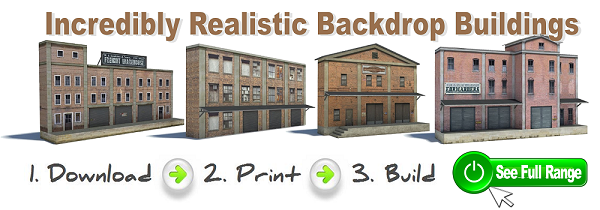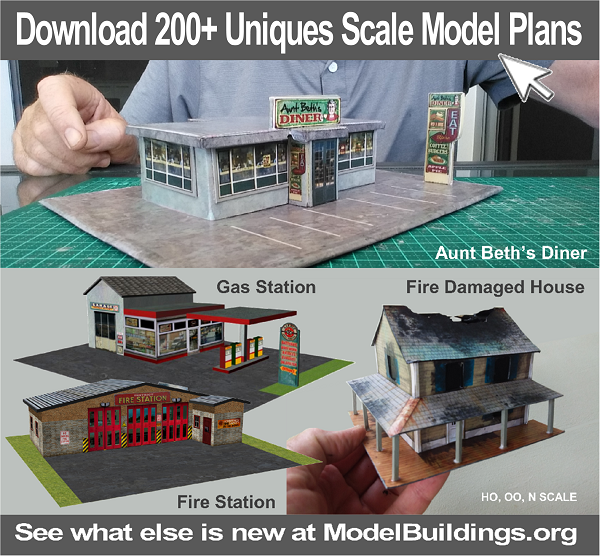Getting Started Planning Model Railway Scenery and Structures
One of the great things about the hobby of model rail- roading is, that unless you are modeling a very specific place complete to the last detail, you get to make your own world according to your own imagination. Scenery construction is the most creative part of model railroad-ing, and it’s really very easy to create some parts of na-ture in miniature. One of the great things about nature is its randomness. Look at any stream, or a mountain peak, or any tree leaf. Although the laws of physics and biology govern how certain things happen in the world, they do happen in a wonderful variety of ways. A stream will follow the path of least resistance down a slope, but the slope itself is a result of the interaction of other forces. In your model world, you get to be the simulator of those forces. © Copyright https://www.modelbuildings.org/ All rights reserved.
Traditional Modeling Techniques
Years ago, the most common construction materials for model railroading were wood, window screening, and paper Mache. Thankfully, we have materials today that are much easier to work with and give superior results.
Modeling Materials Available Today
Extruded insulating foam board (extruded foam) is prob-ably the easiest material to work with to create scenic terrain. It is easily cut with a hot wire knife or utility knife and can be glued into any shape with commonly availa-ble adhesives. Although working the foam can create a snowstorm of tiny particles that tend to stick to things,
they are easily vacuumed up at the end of a con-struction session. Mountains are easily made with layers of rough contour shapes glued together with products like Liquid Nails construction adhesive. Once dry, the shapes may be gouged with sharp tools, sanded and trimmed. Application of rock faces molded from plaster of Paris and filling gaps with modeling products such as Sculptamold create dramatic shapes almost effortlessly. Thinned paints, ground foam, and commercial or handmade trees and other items are easily put in place to complete the effect.
Modeling Accessories For Added Detail : Model Railway Scenery and Structures
If you decide that super detailing your rolling stock is your passion, there are dozens of manufacturers of tiny parts such as snow plows, grab rails, vent louvers, horns and antennas that can be applied to any loco-motive or other rolling stock to customize it into prototypical appearance and historical accuracy.
Perhaps you like to build kits. Buildings, manufacturing plants, rolling stock, vehicles and all manner of the things of the world can be found with a simple Google search, or a trip through the range of around 300 downloadable model buildings and structures available on this website.
A free catalog is available for download (the link is on the home page), and it includes an incredibly varied range of downloadable 3D plans that can be constructed from cardboard and balsa wood, as well as an interesting selection of back-ground buildings that can be built from corflute or card.
There are plans featuring structures from different eras from modern day, right back to the wild west days. The plans also encompass designs of buildings and structures from different parts of the world: the UK, Europe, USA, Canada, Australia, New Zealand etc. So, regardless of the era or geographical location your railroad is modeled on, there are scale model structure plans available for easy download. The good thing is; the constructed models not only look wonderfully realistic, they cost a lot less than plastic models, and are incredibly durable when finished. The selection includes scale model houses, industries, silos, shipping containers, farm structures, bridges, walls, city buildings, emergency ser-vice buildings, terraced houses and shops, old wild west buildings, and more.
Planning And Constructing Layouts One Bite At a Time
If you look at building the layout as a whole, it can appear to be a huge job! Breaking the process down and dealing with one thing at a time makes the end result seem much more achievable. Pick your space first, and then imagine your railroad legend. Then create a track plan that makes the trains the focal point of the legend, followed by a benchwork design to support it. Lay the track and work hard at making it the most perfect part of the layout. Nothing kills enthusiasm for any project like poor performance, and bad track is very hard to fix after you’ve moved on to installing scenery and the finishing touches.
Model Railway Scenery
Scenery is the final piece of the layout, and before you dive right in and start cutting foam board, take some time to do a lot of reading on scenery construction. There are probably more books, magazine articles and blogs published about scenery construction than any other part of modeling. Practice techniques on bits of scrap wood, track and foam until you are comfortable you have selected the best methods for your own lay-out. Scenery is easy to do well if you keep a light touch and add elements in layers. That gives you control over the amount of scenery you put in place and also gives you a better chance to redo something that might have not turned out the way you intended.




